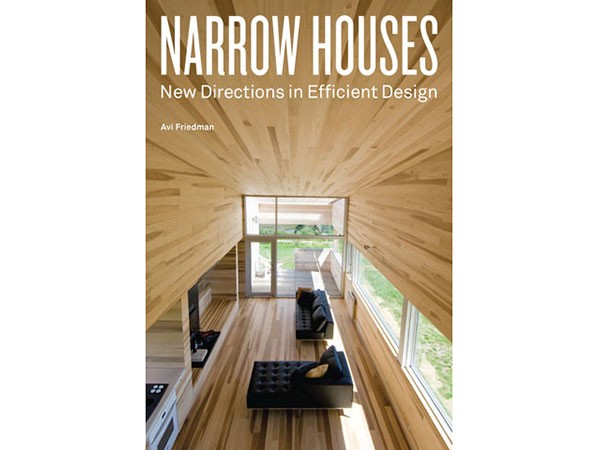Author: Avi Friedman (Princeton Architectural Press, 2010)
Avi Friedman is an architecture professor at McGill University who has been researching narrow dwellings since the 1990s, and sharing his knowledge through several well-known titles such as The Grow Home (2006) and The Adaptable House (2002). His 2010 book, Narrow Houses: New Directions in Efficient Design, builds on his past works through case studies and essays gathered from years of investigations and teachings.
In this collection Friedman looks specifically at twenty-eight narrow houses and four principle topics. The book is well laid-out with stunning photos and architectural drawings and, as such, is an excellent starting point for both students and designers interested in the architecture and culture of narrow dwellings.
Through photographs and drawings Dr. Friedman uses the first half of the book to showcase a series of detached dwellings and townhouses. Each home varies in geographic setting, size, material and client need. Examples include, The Hollybarn, in Norfolk England–a 3500 sq.ft home designed on an environmentally sensitive rural site for a wheelchair-bound client with a large family, as well as Shigeru Ban’s well-known Glass Shutter House in Japan–a dwelling that is less than a quarter of that size and accommodates a chef, his family and their family-business. A brief description accompanies the images and drawings, describing the home, it’s context, spatial and material choices, site specifications and its environmental needs. Each study is unique, well thought-out and under 25′ wide.
The second section of the book is comprised of four essays on Design Principles, Footprints and Volumes, Interiors, and Historical Chronology. Although they only occupy the last 50-pages of the book, Dr. Friedman’s writing is a key aspect to the work as a whole. The essays are concise and easy to read, yet cover a lot of ground from the spatial implication of familial relationships to the structural requirements for a suspended ceiling.
They read like a TED talk for Narrow Houses–brief but filled with useful information, and an excellent starting place for further research. Overall, Narrow Houses is a great book and I would recommend it for designers, builders and students, interested in the history of narrow dwellings as well as its modern manifestation. Although Dr. Friedman doesn’t always go into great detail about each topic, the amount of information touched upon is focused and impressive and the bibliography is an excellent resource.
***
For more information visit the Princeton Architectural Press website.
**
Ellen Ziegler has a Masters in Advanced Studies of Architecture. She lives in Toronto and spends most of her time biking, exploring the city, drinking coffee, and writing book reviews.




One comment
Have a valid Toronto Public Library card? Borrow a copy from the Toronto Public Library or have a look at a copy at the Toronto Reference Library:
http://www.torontopubliclibrary.ca/detail.jsp?Entt=RDM2721195&R=2721195